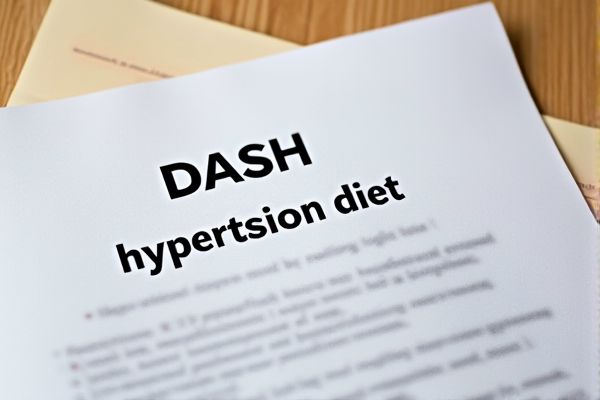Explore a selection of free XLS templates designed specifically for managing a DASH hypertension diet. These templates provide organized meal plans, allowing you to track daily intake of fruits, vegetables, whole grains, and low-fat dairy. Each sheet offers a user-friendly layout to monitor sodium levels and ensure adherence to dietary guidelines, making it easier for you to maintain heart health.
DASH hypertension diet Excel template
DASH hypertension diet tracker
The DASH hypertension diet tracker Excel template is a customizable tool designed to help individuals monitor their dietary habits in alignment with the Dietary Approaches to Stop Hypertension (DASH) diet. This template typically includes sections for tracking daily food intake, recording nutrient values, and evaluating compliance with DASH dietary recommendations, such as increased fruits, vegetables, and whole grains. Users can input their meals and snacks, allowing for an easy assessment of sodium intake and other key dietary components essential for managing blood pressure. This resource can serve basic needs for meal planning and nutrient tracking while offering potential for more advanced uses like customizing nutrient targets or analyzing dietary patterns over time.
💾 DASH hypertension diet tracker template .xls
DASH diet weekly menu
A DASH diet weekly menu Excel template provides a structured approach to meal planning that emphasizes fruits, vegetables, whole grains, and lean proteins, designed to lower blood pressure and improve overall health. This template typically includes columns for each day of the week, listing meals for breakfast, lunch, dinner, and snacks, with a focus on specific nutrient goals like reducing sodium intake. You can customize it by adding your favorite recipes while ensuring portions and ingredients align with DASH dietary guidelines. With this tool, you can easily track your nutrient intake and identify further potential needs for meal variety and advanced meal prep techniques.
💾 DASH diet weekly menu template .xls
DASH diet food diary
A DASH diet food diary Excel template is a structured tool designed to help you track your daily food intake while following the Dietary Approaches to Stop Hypertension (DASH) diet. This template typically includes sections for logging meals, snacks, portion sizes, and nutrient content, making it easier to stay within recommended guidelines for sodium, potassium, and magnesium. It often features automated calculations to summarize daily totals, ensuring you can monitor your progress effectively. Such a template not only supports weight management but also promotes heart health, making it useful for those with specific dietary needs or goals. By incorporating detailed logging and analysis, you can identify patterns in your eating habits while assessing compliance with the DASH diet principles. The basic usage focuses on daily meal tracking, while advanced features might include macros calculations, recipe inputs, and integration with fitness tracking apps for a comprehensive dietary approach.
💾 DASH diet food diary template .xls
DASH diet sodium tracker
DASH diet sodium tracker Excel template serves as a tool to help you monitor sodium intake while following the Dietary Approaches to Stop Hypertension guidelines. The template typically includes pre-formatted tables for logging daily food consumption, along with their corresponding sodium values, ensuring a straightforward tracking process. You can customize the template to reflect personal dietary preferences, enhancing your ability to maintain a low-sodium regimen effectively. This basic usage can be expanded to include advanced features like macro tracking, nutrient analysis, and personalized meal planning based on specific health goals.
💾 DASH diet sodium tracker template .xls
DASH diet nutrient calculator
The DASH diet nutrient calculator Excel template is a spreadsheet tool designed to help users track their nutritional intake while following the DASH (Dietary Approaches to Stop Hypertension) diet. This template typically includes sections for recording daily food consumption, which helps in calculating key nutrients such as sodium, potassium, fiber, and calcium. You will find pre-set formulas that allow for easy data entry, ensuring a user-friendly experience for monitoring dietary goals. Such templates can assist in personalized nutrition planning, making it easier to adhere to the diet and adjust based on individual health needs and preferences. The basic usage focuses on tracking nutrient intake, while further potential needs may involve incorporating more advanced features like macro tracking, meal planning automation, or integration with health apps for comprehensive dietary management.
💾 DASH diet nutrient calculator template .xls
DASH diet progress chart
A DASH diet progress chart Excel template provides a structured way to track dietary habits and health improvements while following the DASH (Dietary Approaches to Stop Hypertension) diet. It typically includes sections to record daily or weekly intake of fruits, vegetables, whole grains, and lean proteins, as well as monitoring sodium, sugar, and saturated fat consumption. The template may also feature a visual representation of weight loss or blood pressure changes over time, making it easier to assess progress. Customizing this template can further enhance your ability to align dietary goals with advanced tracking of macronutrients, micronutrients, and overall wellness indicators.
💾 DASH diet progress chart template .xls
DASH diet printable
A DASH diet printable Excel template provides a structured tool for individuals aiming to adopt the Dietary Approaches to Stop Hypertension (DASH) regimen. This template typically includes meal plans, grocery lists, and portion sizes that focus on fruits, vegetables, whole grains, and lean proteins while minimizing sodium intake. Users can easily customize servings according to personal dietary needs, making meal prep more accessible and organized. In cases of specific health goals or conditions, advanced features such as macronutrient tracking or nutrient timing could further enhance nutritional management.

